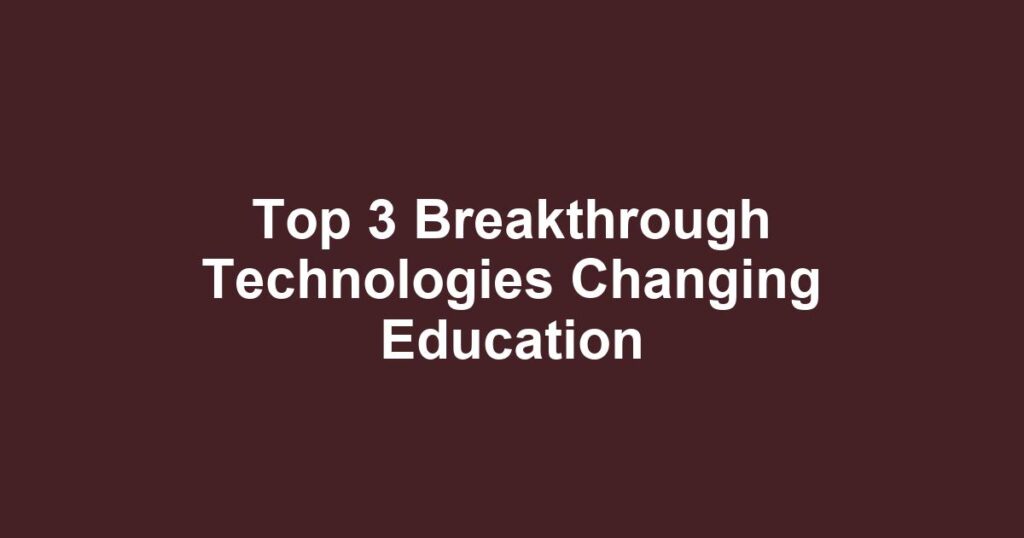Introduction
In recent years, education technology has experienced explosive growth, leading to various innovations that are revolutionizing the learning landscape. From digital classrooms to interactive learning tools, these advancements not only enhance the educational experience but also address diverse learning needs. In this article, we’ll explore the top 3 breakthrough technologies changing education today and how they contribute to significant learning advancements.
1. Artificial Intelligence (AI) in Education
Artificial Intelligence (AI) is undoubtedly one of the most transformative education technologies. By analyzing data and predicting student needs, AI is helping educators improve the learning experience.
Personalized Learning
- AI systems can tailor learning materials based on individual student performance and preferences.
- This level of customization aids in addressing varying learning speeds and styles, making education more accessible.
- For example, platforms like DreamBox Learning and Knewton utilize adaptive learning technologies to create a personalized path for each student.
Intelligent Tutoring Systems
These systems offer one-on-one tutoring experiences that mimic human assistance:
- AI tutors can assess student understanding in real-time and provide instant feedback.
- Platforms like Carnegie Learning and IBM Watson Education are paving the way for students to receive immediate support in subjects such as math and science.
How AI Drives Efficiency in Administrative Tasks
AI doesn’t just benefit students; it also streamlines tasks for educators:
- Automated grading systems reduce workload, allowing teachers to focus on instructional quality.
- Data analysis tools assist schools in identifying trends, improving curriculums, and enhancing student engagement.
2. Virtual and Augmented Reality (VR/AR)
Virtual and Augmented Reality technologies represent a leap forward in educational experiences that are both immersive and engaging.
Immersive Learning Environments
- VR provides students with fully immersive learning experiences, taking them on virtual field trips around the world.
- Programs like Google Expeditions allow learners to explore the depths of the ocean or tour historical landmarks, all from their classroom.
Enhanced Engagement through AR
AR technology overlays digital information onto the physical world, enhancing the learning experience:
- Tools like Merge Cube allow students to visualize complex concepts, such as human anatomy or astronomy, in a 3D format.
- This hands-on interaction promotes better retention of information and encourages curiosity.
Real-World Applications
Incorporating VR and AR into curricula can prepare students for future careers:
- Medical students use VR simulations for practicing surgeries.
- Engineering students can visualize designs before creating prototypes, increasing their understanding of materials and functionality.
3. Gamification in Learning
Another noteworthy trend in education technology is gamification, which incorporates game elements into the learning process. This method aims to increase engagement and motivation among students.
Making Learning Fun
- Gamification turns mundane tasks into exciting challenges, ensuring that students remain enthusiastic about learning.
- Platforms like Kahoot! and Quizlet allow educators to create interactive quizzes that students can enjoy while learning.
Building Essential Skills
By engaging with game mechanics, students develop essential skills:
- Critical thinking and problem-solving become second nature as students tackle challenges.
- Collaboration is fostered through team-based games that encourage communication and teamwork.
Tracking Progress and Rewarding Achievements
Gamification allows both teachers and students to track progress effectively:
- Points, badges, and leaderboards create a sense of competition and accomplishment, motivating students to reach their goals.
- Educators can quickly assess which areas students excel in and which may need additional support.
Conclusion
As we’ve explored, the intersection of education technology and innovation is creating a dynamic landscape in educational settings. AI offers personalized learning experiences, while VR and AR provide engagement through immersive environments, and gamification makes learning enjoyable. These learning advancements are changing how educators teach and how students learn, ultimately driving academic achievement and fostering lifelong learning.
What will be the next breakthrough in education technology, and how will it impact future generations? The possibilities are endless, and staying current with these innovations is essential for educators, students, and parents alike.
Call to Action
Are you ready to embrace these technologies in your learning journey or educational environment? Start exploring innovative tools and methods today to enhance your educational experience. Whether you’re an educator aiming to improve your classroom dynamics or a student looking to augment your learning, the tools available today can lead to remarkable advancements in how we acquire knowledge.

